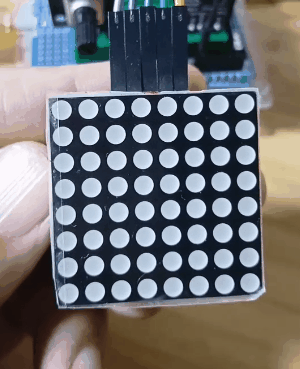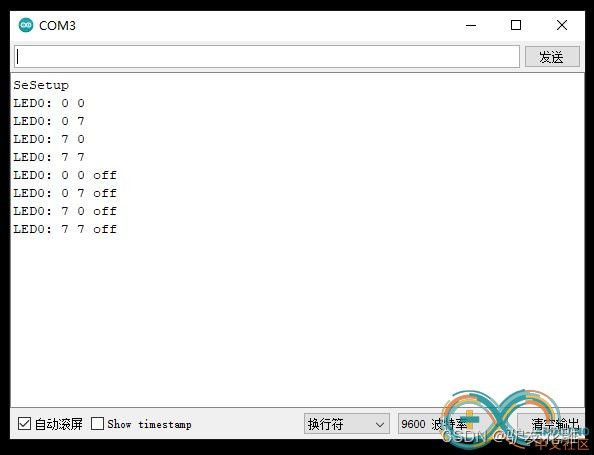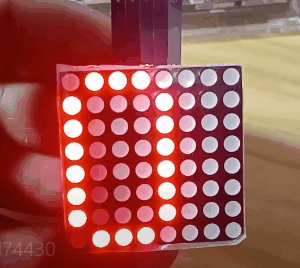【雕爷学编程】Arduino动手做(22)——8X8 LED点阵MAX7219屏6
37款传感器与模块的提法,在网络上广泛流传,其实Arduino能够兼容的传感器模块肯定是不止37种的。鉴于本人手头积累了一些传感器和模块,依照实践出真知(一定要动手做)的理念,以学习和交流为目的,这里准备逐一动手试试做实验,不管成功与否,都会记录下来—小小的进步或是搞不定的问题,希望能够抛砖引玉。
【Arduino】108种传感器模块系列实验(资料+代码+图形+仿真)
实验二十二:MAX7219点阵显示模块(8X8 LED共阴屏幕)
【Arduino】168种传感器模块系列实验(资料代码+仿真编程+图形编程)
实验二十二:MAX7219点阵显示模块(8X8 LED共阴)
项目三十三:动态红心
实验开源代码
/*
【Arduino】168种传感器模块系列实验(资料代码+仿真编程+图形编程)
实验二十二:MAX7219点阵显示模块(8X8 LED共阴)
项目三十三:动态红心
接脚连线:
MAX7219 UNO
VCC →→→→→ 5V
GND →→→→→ GND
DIN →→→→→ D12(数据,数据接收引脚)
CS →→→→→ D11(负载,命令接收引脚)
CLK →→→→→ D10(时钟,时钟引脚)
*/
unsigned char i;
unsigned char j;
int Max7219_pinCLK = 10;
int Max7219_pinCS = 11;
int Max7219_pinDIN = 12;
unsigned char disp1[19][8]={0x0c,0x1e,0x3e,0x7c,0x7c,0x3e,0x1e,0x0c};
void Write_Max7219_byte(unsigned char DATA)
{
unsigned char i;
digitalWrite(Max7219_pinCS,LOW);
for(i=8;i>=1;i--)
{
digitalWrite(Max7219_pinCLK,LOW);
digitalWrite(Max7219_pinDIN,DATA&0x80);
DATA = DATA<<1;
digitalWrite(Max7219_pinCLK,HIGH);
}
}
void Write_Max7219(unsigned char address,unsigned char dat)
{
digitalWrite(Max7219_pinCS,LOW);
Write_Max7219_byte(address);
Write_Max7219_byte(dat);
digitalWrite(Max7219_pinCS,HIGH);
}
void Init_MAX7219(void)
{
Write_Max7219(0x09, 0x00);
Write_Max7219(0x0a, 0x03);
Write_Max7219(0x0b, 0x07);
Write_Max7219(0x0c, 0x01);
Write_Max7219(0x0f, 0x00);
}
void setup()
{
pinMode(Max7219_pinCLK,OUTPUT);
pinMode(Max7219_pinCS,OUTPUT);
pinMode(Max7219_pinDIN,OUTPUT);
delay(500);
Init_MAX7219();
}
void loop()
{
for(j=0;j<19;j++)
{
for(i=1;i<9;i++)
Write_Max7219(i,disp1[j][i-1]);
delay(500);
}
}
【Arduino】168种传感器模块系列实验(资料代码+仿真编程+图形编程)
实验二十二:MAX7219点阵显示模块(8X8 LED共阴)
项目三十四:打开/关闭其 LED 组合显示 ASCII 字符
实验开源代码
/*
【Arduino】168种传感器模块系列实验(资料代码+仿真编程+图形编程)
实验二十二:MAX7219点阵显示模块(8X8 LED共阴)
项目三十四:打开/关闭其 LED 组合显示 ASCII 字符
接脚连线:
MAX7219 UNO
VCC →→→→→ 5V
GND →→→→→ GND
DIN →→→→→ D12(数据,数据接收引脚)
CS →→→→→ D11(负载,命令接收引脚)
CLK →→→→→ D10(时钟,时钟引脚)
*/
//We always have to include the library
#include "LedControlMS.h"
/*
Now we need a LedControl to work with.
***** These pin numbers will probably not work with your hardware *****
pin 12 is connected to the DataIn
pin 11 is connected to the CLK
pin 10 is connected to LOAD
We have only a single MAX72XX.
*/
#define NBR_MTX 2
LedControl lc=LedControl(12,10,11, NBR_MTX);
String digits= "1234567890";
int digitCounter=0;
/* we always wait a bit between updates of the display */
unsigned long delaytime=300;
void setup() {
/*
The MAX72XX is in power-saving mode on startup,
we have to do a wakeup call
*/
Serial.begin (9600);
Serial.println("Setup");
digitCounter=0;
for (int i=0; i< NBR_MTX; i++){
lc.shutdown(i,false);
/* Set the brightness to a medium values */
lc.setIntensity(i,8);
/* and clear the display */
lc.clearDisplay(i);
}
Serial.println("LED0: 0 0");
lc.setLed(0,0,0,true);
delay(1000);
Serial.println("LED0: 0 7");
lc.setLed(0,0,7,true);
delay(1000);
Serial.println("LED0: 7 0");
lc.setLed(0,7,0,true);
delay(1000);
Serial.println("LED0: 7 7");
lc.setLed(0,7,7,true);
delay(1000);
Serial.println("LED0: 0 0 off");
lc.setLed(0,0,0,false);
delay(1000);
Serial.println("LED0: 0 7 off");
lc.setLed(0,0,7,false);
delay(1000);
Serial.println("LED0: 7 0 off");
lc.setLed(0,7,0,false);
delay(1000);
Serial.println("LED0: 7 7 off");
lc.setLed(0,7,7,false);
delay(1000);
//clearAll();
lc.setRow(0,1,0x0C);
delay(1000);
lc.clearDisplay(0);
lc.setRow(0,1,0xC0);
delay(1000);
lc.clearDisplay(0);
lc.setColumn(0,1,0x0C);
delay(1000);
lc.clearDisplay(0);
lc.setColumn(0,1,0xC0);
delay(1000);
lc.clearDisplay(0);
lc.writeString(0,"Hola Mundo");
delay(1000);
lc.clearAll();
scrollLeft('O');
delay(1000);
lc.clearAll();
scrollRight('O');
delay(1000);
lc.clearAll();
}
void loop() {
char ch= digits[digitCounter];
digitCounter++;
if (digitCounter>9) digitCounter=0;
lc.displayChar(0, lc.getCharArrayPosition(ch));
delay(500);
lc.clearAll();
delay(200);
}
void scrollLeft(char ch){
int pos =lc.getCharArrayPosition(ch);
for (int scroll =0; scroll<6; scroll++) {
for (int i=scroll; i<6;i++) {
lc.setRow(0,i-scroll, alphabetBitmap[pos][i]);
}
delay(200);
lc.clearDisplay(0);
}
}
void scrollRight(char ch){
int pos =lc.getCharArrayPosition(ch);
for (int scroll =0; scroll<8; scroll++) {
for (int i=0; i<6;i++) {
if (scroll+i<8) lc.setRow(0, scroll+i, alphabetBitmap[pos][i]);
}
delay(200);
lc.clearDisplay(0);
}
}
实验串口返回情况
【Arduino】168种传感器模块系列实验(资料代码+仿真编程+图形编程)
实验二十二:MAX7219点阵显示模块(8X8 LED共阴)
项目三十五:逐点排列
实验开源代码
/*
【Arduino】168种传感器模块系列实验(资料代码+仿真编程+图形编程)
实验二十二:MAX7219点阵显示模块(8X8 LED共阴)
项目三十五:逐点排列
接脚连线:
MAX7219 UNO
VCC →→→→→ 5V
GND →→→→→ GND
DIN →→→→→ D12(数据,数据接收引脚)
CS →→→→→ D11(负载,命令接收引脚)
CLK →→→→→ D10(时钟,时钟引脚)
*/
//We always have to include the library
#include "LedControlMS.h"
/*
Now we need a LedControl to work with.
***** These pin numbers will probably not work with your hardware *****
pin 12 is connected to the DataIn
pin 11 is connected to the CLK
pin 10 is connected to LOAD
We have only a single MAX72XX.
*/
LedControl lc=LedControl(12,10,11,1);
/* we always wait a bit between updates of the display */
unsigned long delaytime=100;
void setup() {
/*
The MAX72XX is in power-saving mode on startup,
we have to do a wakeup call
*/
lc.shutdown(0,false);
/* Set the brightness to a medium values */
lc.setIntensity(0,8);
/* and clear the display */
lc.clearDisplay(0);
}
/*
This method will display the characters for the
word "Arduino" one after the other on the matrix.
(you need at least 5x7 leds to see the whole chars)
*/
void writeArduinoOnMatrix() {
/* here is the data for the characters */
byte a[5]={B01111110,B10001000,B10001000,B10001000,B01111110};
byte r[5]={B00111110,B00010000,B00100000,B00100000,B00010000};
byte d[5]={B00011100,B00100010,B00100010,B00010010,B11111110};
byte u[5]={B00111100,B00000010,B00000010,B00000100,B00111110};
byte i[5]={B00000000,B00100010,B10111110,B00000010,B00000000};
byte n[5]={B00111110,B00010000,B00100000,B00100000,B00011110};
byte o[5]={B00011100,B00100010,B00100010,B00100010,B00011100};
/* now display them one by one with a small delay */
lc.setRow(0,0,a[0]);
lc.setRow(0,1,a[1]);
lc.setRow(0,2,a[2]);
lc.setRow(0,3,a[3]);
lc.setRow(0,4,a[4]);
delay(delaytime);
lc.setRow(0,0,r[0]);
lc.setRow(0,1,r[1]);
lc.setRow(0,2,r[2]);
lc.setRow(0,3,r[3]);
lc.setRow(0,4,r[4]);
delay(delaytime);
lc.setRow(0,0,d[0]);
lc.setRow(0,1,d[1]);
lc.setRow(0,2,d[2]);
lc.setRow(0,3,d[3]);
lc.setRow(0,4,d[4]);
delay(delaytime);
lc.setRow(0,0,u[0]);
lc.setRow(0,1,u[1]);
lc.setRow(0,2,u[2]);
lc.setRow(0,3,u[3]);
lc.setRow(0,4,u[4]);
delay(delaytime);
lc.setRow(0,0,i[0]);
lc.setRow(0,1,i[1]);
lc.setRow(0,2,i[2]);
lc.setRow(0,3,i[3]);
lc.setRow(0,4,i[4]);
delay(delaytime);
lc.setRow(0,0,n[0]);
lc.setRow(0,1,n[1]);
lc.setRow(0,2,n[2]);
lc.setRow(0,3,n[3]);
lc.setRow(0,4,n[4]);
delay(delaytime);
lc.setRow(0,0,o[0]);
lc.setRow(0,1,o[1]);
lc.setRow(0,2,o[2]);
lc.setRow(0,3,o[3]);
lc.setRow(0,4,o[4]);
delay(delaytime);
lc.setRow(0,0,0);
lc.setRow(0,1,0);
lc.setRow(0,2,0);
lc.setRow(0,3,0);
lc.setRow(0,4,0);
delay(delaytime);
}
/*
This function lights up a some Leds in a row.
The pattern will be repeated on every row.
The pattern will blink along with the row-number.
row number 4 (index==3) will blink 4 times etc.
*/
void rows() {
for(int row=0;row<8;row++) {
delay(delaytime);
lc.setRow(0,row,B10100000);
delay(delaytime);
lc.setRow(0,row,(byte)0);
for(int i=0;i<row;i++) {
delay(delaytime);
lc.setRow(0,row,B10100000);
delay(delaytime);
lc.setRow(0,row,(byte)0);
}
}
}
/*
This function lights up a some Leds in a column.
The pattern will be repeated on every column.
The pattern will blink along with the column-number.
column number 4 (index==3) will blink 4 times etc.
*/
void columns() {
for(int col=0;col<8;col++) {
delay(delaytime);
lc.setColumn(0,col,B10100000);
delay(delaytime);
lc.setColumn(0,col,(byte)0);
for(int i=0;i<col;i++) {
delay(delaytime);
lc.setColumn(0,col,B10100000);
delay(delaytime);
lc.setColumn(0,col,(byte)0);
}
}
}
/*
This function will light up every Led on the matrix.
The led will blink along with the row-number.
row number 4 (index==3) will blink 4 times etc.
*/
void single() {
for(int row=0;row<8;row++) {
for(int col=0;col<8;col++) {
delay(delaytime);
lc.setLed(0,row,col,true);
delay(delaytime);
for(int i=0;i<col;i++) {
lc.setLed(0,row,col,false);
delay(delaytime);
lc.setLed(0,row,col,true);
delay(delaytime);
}
}
}
}
void loop() {
writeArduinoOnMatrix();
rows();
columns();
single();
}
【Arduino】168种传感器模块系列实验(资料代码+仿真编程+图形编程)
实验二十二:MAX7219点阵显示模块(8X8 LED共阴)
项目三十六:快速扫描矩阵所以点
实验开源代码
/*
【Arduino】168种传感器模块系列实验(资料代码+仿真编程+图形编程)
实验二十二:MAX7219点阵显示模块(8X8 LED共阴)
项目三十六:快速扫描矩阵所以点
接脚连线:
MAX7219 UNO
VCC →→→→→ 5V
GND →→→→→ GND
DIN →→→→→ D12(数据,数据接收引脚)
CS →→→→→ D11(负载,命令接收引脚)
CLK →→→→→ D10(时钟,时钟引脚)
*/
//We always have to include the library
#include "LedControlMS.h"
/*
Now we need a LedControl to work with.
***** These pin numbers will probably not work with your hardware *****
pin 12 is connected to the DataIn
pin 11 is connected to the CLK
pin 10 is connected to LOAD
***** Please set the number of devices you have *****
But the maximum default of 8 MAX72XX wil also work.
*/
LedControl lc=LedControl(12,10,11,1);
/* we always wait a bit between updates of the display */
unsigned long delaytime=10;
/*
This time we have more than one device.
But all of them have to be initialized
individually.
*/
void setup() {
//we have already set the number of devices when we created the LedControl
int devices=lc.getDeviceCount();
//we have to init all devices in a loop
for(int address=0;address<devices;address++) {
/*The MAX72XX is in power-saving mode on startup*/
lc.shutdown(address,false);
/* Set the brightness to a medium values */
lc.setIntensity(address,8);
/* and clear the display */
lc.clearDisplay(address);
}
}
void loop() {
//read the number cascaded devices
int devices=lc.getDeviceCount();
//we have to init all devices in a loop
for(int row=0;row<8;row++) {
for(int col=0;col<8;col++) {
for(int address=0;address<devices;address++) {
delay(delaytime);
lc.setLed(address,row,col,true);
delay(delaytime);
lc.setLed(address,row,col,false);
}
}
}
}

【Arduino】168种传感器模块系列实验(资料代码+仿真编程+图形编程)
实验二十二:MAX7219点阵显示模块(8X8 LED共阴)
项目三十七:动态字符串
实验开源代码
/*
【Arduino】168种传感器模块系列实验(资料代码+仿真编程+图形编程)
实验二十二:MAX7219点阵显示模块(8X8 LED共阴)
项目三十七:动态字符串
接脚连线:
MAX7219 UNO
VCC →→→→→ 5V
GND →→→→→ GND
DIN →→→→→ D12(数据,数据接收引脚)
CS →→→→→ D11(负载,命令接收引脚)
CLK →→→→→ D10(时钟,时钟引脚)
*/
//We always have to include the library
#include "LedControlMS.h"
/*
Now we need a LedControl to work with.
***** These pin numbers will probably not work with your hardware *****
pin 12 is connected to the DataIn
pin 11 is connected to the CLK
pin 10 is connected to LOAD
We have only a single MAX72XX.
*/
LedControl lc=LedControl(12,10,11,1);
/* we always wait a bit between updates of the display */
unsigned long delaytime=250;
void setup() {
/*
The MAX72XX is in power-saving mode on startup,
we have to do a wakeup call
*/
lc.shutdown(0,false);
/* Set the brightness to a medium values */
lc.setIntensity(0,8);
/* and clear the display */
lc.clearDisplay(0);
}
/*
This method will display the characters for the
word "Arduino" one after the other on digit 0.
*/
void writeArduinoOn7Segment() {
lc.setChar(2,0,'a',false);
delay(delaytime);
lc.setRow(2,0,0x05);
delay(delaytime);
lc.setChar(2,0,'d',false);
delay(delaytime);
lc.setRow(2,0,0x1c);
delay(delaytime);
lc.setRow(2,0,B00010000);
delay(delaytime);
lc.setRow(2,0,0x15);
delay(delaytime);
lc.setRow(2,0,0x1D);
delay(delaytime);
lc.clearDisplay(0);
delay(delaytime);
}
/*
This method will scroll all the hexa-decimal
numbers and letters on the display. You will need at least
four 7-Segment digits. otherwise it won't really look that good.
*/
void scrollDigits() {
for(int i=0;i<13;i++) {
lc.setDigit(0,3,i,false);
lc.setDigit(0,2,i+1,false);
lc.setDigit(0,1,i+2,false);
lc.setDigit(0,0,i+3,false);
delay(delaytime);
}
lc.clearDisplay(0);
delay(delaytime);
}
void loop() {
writeArduinoOn7Segment();
scrollDigits();
}
Arduino点阵文字(中) 8x8 LED Matrix MAX7219 Tutorial with Scrolling Text
https://www.bilibili.com/video/BV1Et411k7U2?from=search&seid=4477785334025497564&spm_id_from=333.337.0.0
Arduino Nano + MAX7219 8*8点阵组合 汉字显示
https://www.bilibili.com/video/av375403904/?from=search&seid=3172695889868987008&spm_id_from=333.337.0.0





